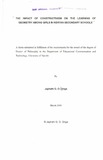The impact of constructivism on the learning of geometry among girls in Kenyan secondary schools

View/
Date
2000Author
Origa, Japheth G. O
Type
ThesisLanguage
enMetadata
Show full item recordAbstract
The study investigated the impact of constructivism (constructivist approach) on the learning of three-dimensional geometry among girls in Kenyan Secondary Schools. The testing form of teaching experiment that involved both bahaviourist and constructivist approaches was used to determine which, of the two approaches is superior in promoting the acquisition of geometry concepts. The experiment was designed to control the effects of pre-testing, the approach and materials used to teach three-dimensional geometry. Learner participants in the study were form three students (seventeen year olds) from sixty-two girls' secondary schools in Kenya.
The study was aimed at: determining the impact of constructivist approach on mastery of geometry concepts, determining the effect of manipulative materials on achievement in geometry, determining the effect of manipulative materials on transfer of geometry skills from concrete to abstract situations, exploring student errors and misconceptions in the learning of three dimensional geometry (three-D), unearthing mathematical learning difficulties encountered during the learning of three-D and to uncover the factors that contribute to poor performance in geometry.
Data for the study were garnered from: questionnaires completed by practicing mathematics teachers, pretest scripts, posttest scripts, and from direct interviews with mathematics teachers. The data were analyzed both qualitatively and quantitatively.
Learners who used the constructivist approach attained superior mean scores and better ranks compared to their counterparts who used the bahaviourist approach irrespective of the materials used for instruction. Results of the analysis of the data from the study suggest that unsatisfactory performance in three-D tasks by Kenyan
female students (at the secondary school level) is a direct consequence of multiple
factors contributing singly and collectively. The factors include: learners' negative attitude, lack of prerequisite concepts, inability to apply prerequisite concepts, conceptual difficulties, abstract nature of three-D, lack of instructional resources, under utilization of instructional resources, deficiency in problem solving skills, language deficiency, over enrolment oflearners and ineffective mode and manner of concept presentation.
The report includes recommendations on: workshops and seminars, mathematics, restructuring the mathematics syllabus, instructional approaches, goals of teaching mathematics, instructional resources, teacher training program, teaching load, evaluation of mathematics learning, basics for mathematics learning and research on mathematics education.
Citation
A thesis submitted in fulfillment of the requirements for the award of the degree of Doctor of Philosophy in the Department of Educational Communication and Technology, University of NairobiPublisher
Department of Education
